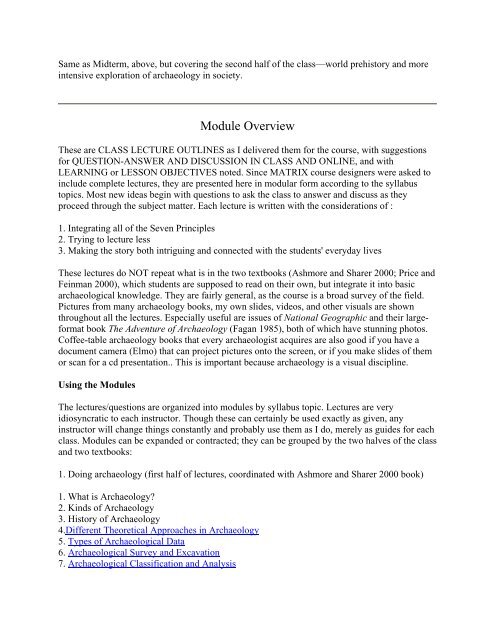INTRODUCTION TO ARCHAEOLOGY Nancy White - Touro Institute
INTRODUCTION TO ARCHAEOLOGY Nancy White - Touro Institute
INTRODUCTION TO ARCHAEOLOGY Nancy White - Touro Institute
Create successful ePaper yourself
Turn your PDF publications into a flip-book with our unique Google optimized e-Paper software.
Same as Midterm, above, but covering the second half of the class—world prehistory and more<br />
intensive exploration of archaeology in society.<br />
Module Overview<br />
These are CLASS LECTURE OUTLINES as I delivered them for the course, with suggestions<br />
for QUESTION-ANSWER AND DISCUSSION IN CLASS AND ONLINE, and with<br />
LEARNING or LESSON OBJECTIVES noted. Since MATRIX course designers were asked to<br />
include complete lectures, they are presented here in modular form according to the syllabus<br />
topics. Most new ideas begin with questions to ask the class to answer and discuss as they<br />
proceed through the subject matter. Each lecture is written with the considerations of :<br />
1. Integrating all of the Seven Principles<br />
2. Trying to lecture less<br />
3. Making the story both intriguing and connected with the students' everyday lives<br />
These lectures do NOT repeat what is in the two textbooks (Ashmore and Sharer 2000; Price and<br />
Feinman 2000), which students are supposed to read on their own, but integrate it into basic<br />
archaeological knowledge. They are fairly general, as the course is a broad survey of the field.<br />
Pictures from many archaeology books, my own slides, videos, and other visuals are shown<br />
throughout all the lectures. Especially useful are issues of National Geographic and their largeformat<br />
book The Adventure of Archaeology (Fagan 1985), both of which have stunning photos.<br />
Coffee-table archaeology books that every archaeologist acquires are also good if you have a<br />
document camera (Elmo) that can project pictures onto the screen, or if you make slides of them<br />
or scan for a cd presentation.. This is important because archaeology is a visual discipline.<br />
Using the Modules<br />
The lectures/questions are organized into modules by syllabus topic. Lectures are very<br />
idiosyncratic to each instructor. Though these can certainly be used exactly as given, any<br />
instructor will change things constantly and probably use them as I do, merely as guides for each<br />
class. Modules can be expanded or contracted; they can be grouped by the two halves of the class<br />
and two textbooks:<br />
1. Doing archaeology (first half of lectures, coordinated with Ashmore and Sharer 2000 book)<br />
1. What is Archaeology?<br />
2. Kinds of Archaeology<br />
3. History of Archaeology<br />
4.Different Theoretical Approaches in Archaeology<br />
5. Types of Archaeological Data<br />
6. Archaeological Survey and Excavation<br />
7. Archaeological Classification and Analysis
















